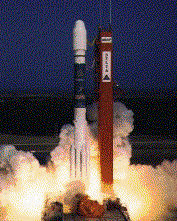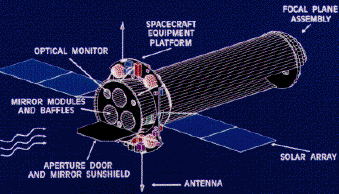Mullard Space Science Laboratory
Astrophysics Projects
 ROSAT - Launched
June 1990
ROSAT - Launched
June 1990
The RoentgenSatellite (ROSAT) is an X-ray and EUV observatory built by a
collaboration between Germany, the US and the UK. There are two X-ray
instruments: the Position Sensitive Proportional Counter (PSPC) which has
spectroscopic and imaging capabilities; and the High Resolution Imager (HRI)
which provides soft X-ray images with about 2-3 arcseconds resolution. After 4
very successful years the PSPC has been turned off because of depletion of the
detector gas supply: the HRI is still in operation.
The third instrument on ROSAT is the Wide Field Camera (WFC) which detects
sources in the extreme ultra-violet; MSSL was part of the UK consortium
responsible for building the WFC. Further information about the ROSAT project
is provided by the High Energy
Astrophysics Science Archive Research Center at the Goddard Space Flight
Center.
 ISO - Launched November 1995
ISO - Launched November 1995
The Infrared Space Observatory (ISO) was funded by the European Space Agency
(ESA) and carried a 60cm diameter mirror with four scientific instruments. MSSL
was a co-investigator of one of the four instruments; the Long Wavelength
Spectrometer (LWS). ISO has addressed many astrophysical topics, from our local
Solar System, to stars and the media surrounding them, to galaxies and
quasars and cosmological models. The Infrared Space Observatory Home Page
provides more information, pictures and scientific results from ISO.
 XMM - Launched 10th December 1999
XMM - Launched 10th December 1999
The X-ray Multi-Mirror Mission (XMM) is an observatory developed by the
European Space Agency (ESA) and will provide X-ray images and spectra for the
world community from about the turn of the millenium. XMM has been designed to
last for ten years, and will be used to probe very hot plasmas (temperatures in
the range of millions to hundreds of millions of degrees). Such plasmas are
found, for example, in interacting binary stars, galaxies, clusters of galaxies
and in quasars. Please visit the UK's XMM web site for more information and a description of the
mission.
MSSL is involved with building two of the three instruments on XMM, the
Optical Monitor and the
Reflection Grating Spectrometer.
 Spectrum X-Gamma - Due for launch 1999
Spectrum X-Gamma - Due for launch 1999
The astrophysical observatory SPECTR-RG is a joint space project of more than
twelve countries being built under the leadership of the Space Research Institute (IKI) in
Moscow. MSSL is part of the consortium building the Jet-X instrument for
Spectrum X-Gamma: visit the Jet-X pages at
MSSL for more information.
 For more information
about these projects and our current Astrophysics research on binary stars,
quasars, the cosmological X-ray background and faint X-ray emitting galaxies,
visit the Astrophysics group's
home page.
For more information
about these projects and our current Astrophysics research on binary stars,
quasars, the cosmological X-ray background and faint X-ray emitting galaxies,
visit the Astrophysics group's
home page.
The following provide links to the projects of the four scientific research
groups at MSSL:

 ROSAT - Launched
June 1990
ROSAT - Launched
June 1990


 For more information
about these projects and our current Astrophysics research on binary stars,
quasars, the cosmological X-ray background and faint X-ray emitting galaxies,
visit the
For more information
about these projects and our current Astrophysics research on binary stars,
quasars, the cosmological X-ray background and faint X-ray emitting galaxies,
visit the